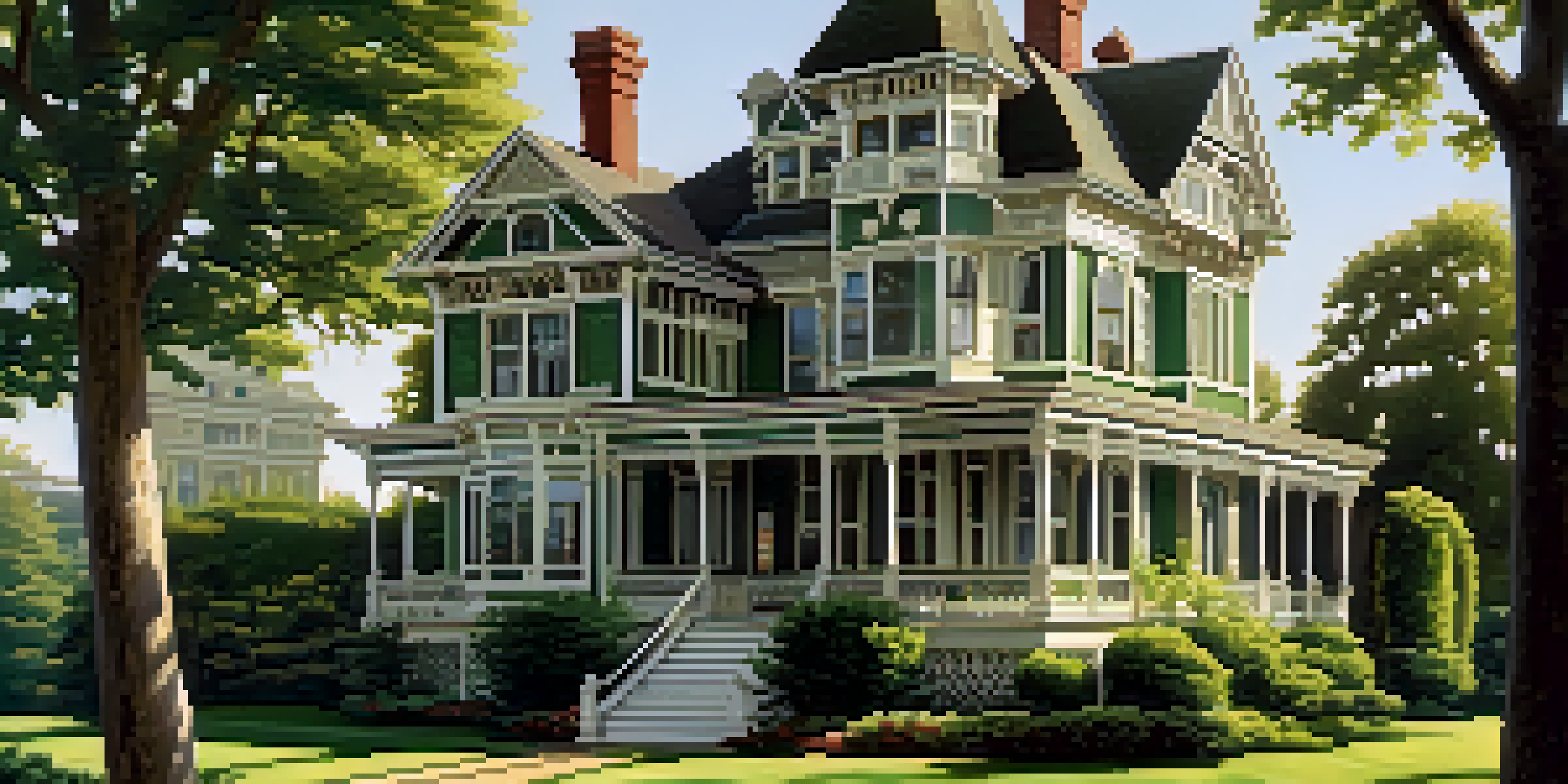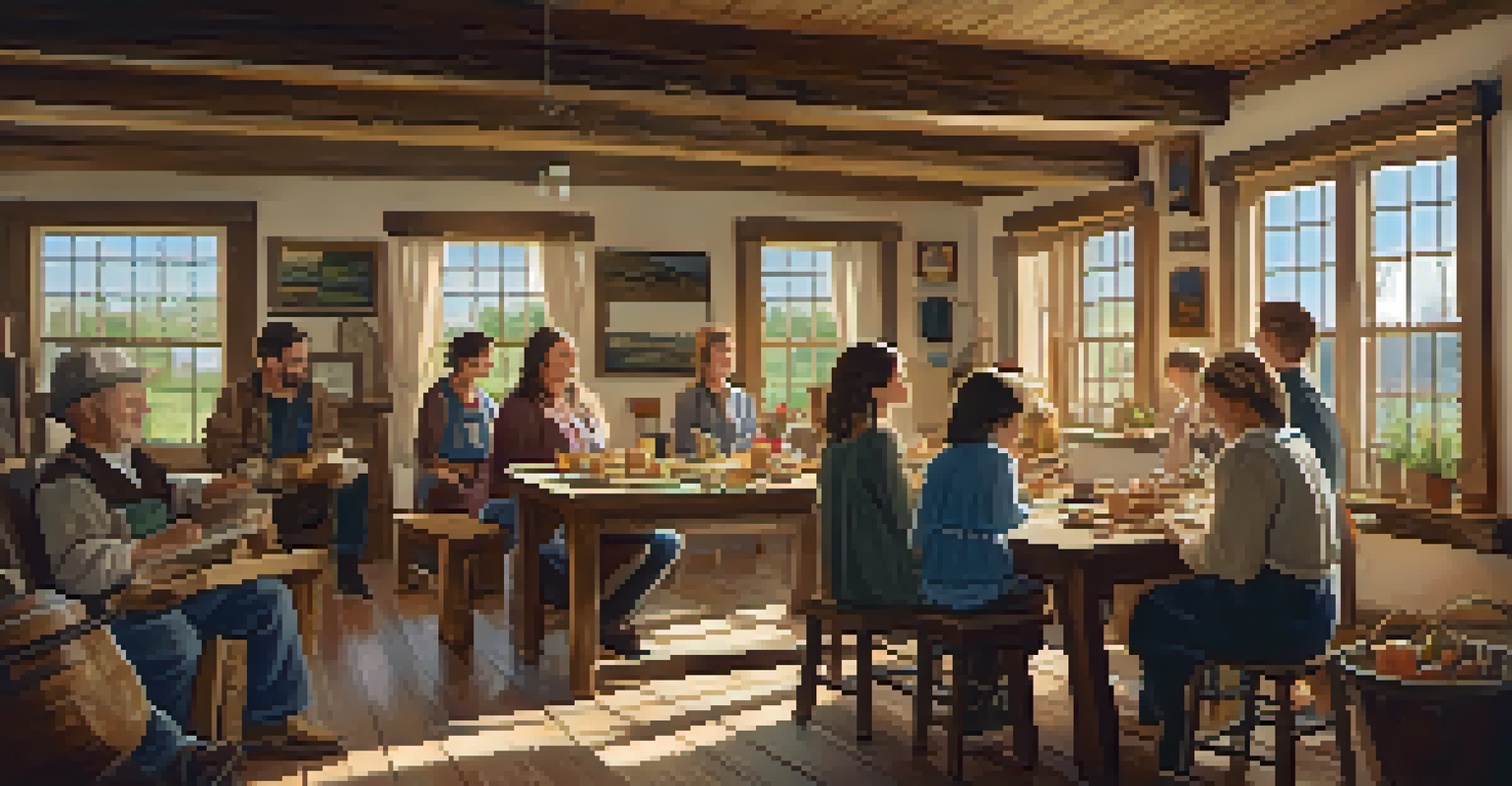Cultural Significance of Preserving Historic Homes Today

Understanding the Importance of Historic Homes
Historic homes serve as tangible connections to our past, offering glimpses into the lives of those who came before us. They tell stories that textbooks often overlook, revealing the unique cultural fabric of a community. By preserving these structures, we ensure that future generations can appreciate and learn from their history.
Preservation is a form of stewardship, a way of making sure that our past is not lost forever to the future.
Moreover, these homes are often architectural treasures that reflect the design styles and craftsmanship of their era. Imagine walking through a Victorian home with its ornate details or a mid-century modern house showcasing innovative materials. Each design choice tells a story about the time it was built and the people who lived there.
In a rapidly changing world, these homes remind us of our roots and the evolution of our society. They help us maintain a sense of identity and continuity, serving as anchors in our communities where history and modern life intersect.
Economic Benefits of Preserving Historic Homes
Preserving historic homes is not just a cultural endeavor; it also has significant economic advantages. These properties can increase property values in surrounding areas, making neighborhoods more desirable for potential buyers. When communities invest in their historic homes, they often see a boost in local real estate markets.

Additionally, historic homes can attract tourists, providing a source of income for local businesses. Think about the charm of a quaint town with well-preserved homes that tell a story—visitors are drawn to these picturesque settings, fueling the economy. Local shops, restaurants, and tour guides thrive in such environments.
Historic Homes Connect Us to the Past
These homes serve as living links to our history, offering insights into the cultural fabric of our communities.
Furthermore, renovation and preservation projects create jobs in construction, craftsmanship, and tourism. Investing in these historic sites can lead to a ripple effect of economic growth, benefiting the community as a whole.
Cultural Heritage and Community Identity
Historic homes are key to understanding and appreciating cultural heritage. They often embody the unique characteristics of the communities they belong to, reflecting local traditions, customs, and values. By preserving these homes, we honor the identities and stories of diverse groups within our society.
Historic preservation is an investment in the future, ensuring that we learn from our past.
Moreover, these homes can serve as community hubs, spaces where people gather for events, celebrations, and educational activities. They foster a sense of belonging and pride among residents, as they become part of a shared narrative that connects individuals across generations.
In this way, historic homes act as living museums, showcasing the evolution of community identity over time. They invite us to explore our roots and understand how past influences shape our present and future.
Environmental Sustainability through Preservation
Preserving historic homes is also an act of environmental sustainability. By maintaining existing structures, we reduce the need for new construction, which can be resource-intensive and damaging to the environment. Keeping these homes intact minimizes waste and conserves materials, making it a more eco-friendly choice.
Additionally, older homes are often built with durable materials and traditional craftsmanship that can outlast modern building methods. Renovating and maintaining these homes can be more sustainable than tearing them down and starting anew. Think of it as nurturing a well-established tree instead of planting a new sapling.
Economic Growth through Preservation
Investing in historic homes boosts local property values and attracts tourism, benefiting the community's economy.
This approach not only reduces our carbon footprint but also encourages communities to think critically about their development practices. It promotes a mindset of valuing what we have rather than constantly seeking the new.
Educational Opportunities in Historic Homes
Historic homes provide valuable educational opportunities for individuals of all ages. They serve as classrooms where people can learn about architecture, history, and the cultural significance of different time periods. Schools and local organizations often use these sites to engage students in hands-on learning experiences.
Imagine a group of students visiting a restored farmhouse, where they can see firsthand how families lived a century ago. Such experiences foster a deeper understanding of history that goes beyond what they read in textbooks. These homes become interactive learning environments that spark curiosity and inspire future generations.
Moreover, many historic homes offer workshops and events that teach traditional crafts, cooking, and skills from the past. These activities not only preserve knowledge but also allow community members to connect with their heritage in meaningful ways.
Community Engagement and Volunteerism
The preservation of historic homes often relies heavily on community engagement and volunteerism. Local organizations and heritage groups rally together to restore and maintain these properties, fostering a sense of camaraderie among residents. This collective effort strengthens community bonds and encourages active participation in local history.
Volunteers often bring diverse skills to the table, from construction experience to artistic talents, making the preservation process a collaborative endeavor. Working side by side on these projects not only enhances skills but also creates lasting friendships and a shared sense of accomplishment.
Community Engagement in Preservation
The process of preserving historic homes fosters community bonds and encourages active participation in local heritage.
Additionally, community events centered around preservation can attract new residents and create a sense of excitement about local heritage. When people feel connected to their community's history, they are more likely to invest in its future.
Challenges in Preserving Historic Homes
While the benefits of preserving historic homes are clear, challenges abound in the process. Funding for restoration projects can be limited, and securing grants or donations often requires extensive planning and outreach. Many communities struggle to find the financial resources needed to maintain these important sites.
Furthermore, there can be bureaucratic hurdles when it comes to navigating preservation regulations and guidelines. Homeowners may face restrictions that make renovations complicated, leading to frustration. It's essential for communities to streamline these processes and provide support for those looking to preserve their homes.

Lastly, changing societal values and urban development pressures can threaten the existence of historic homes. As cities grow and evolve, it becomes increasingly important to advocate for the preservation of these cultural landmarks, ensuring they remain a vital part of our narrative.
The Future of Historic Home Preservation
Looking ahead, the future of historic home preservation depends on a collective commitment to safeguarding our heritage. This involves not only individuals and communities but also policymakers and organizations dedicated to historical conservation. Collaborating across different sectors can lead to innovative solutions that support preservation efforts.
Education and awareness play crucial roles in this journey. By informing community members about the significance of historic homes and how they contribute to local identity, we can inspire action. Engaging storytelling and outreach initiatives can help rally support for preservation efforts.
Ultimately, as we navigate the challenges of modern living, preserving historic homes reminds us of the importance of our roots. They hold the keys to our past and will continue to shape our future, making their preservation an essential endeavor for generations to come.